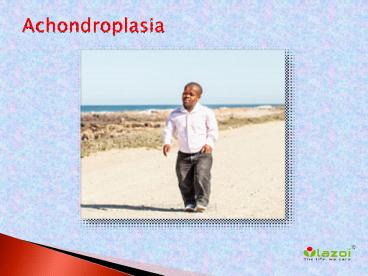Achondroplasia PowerPoint PPT Presentation
Title: Achondroplasia
1
Achondroplasia
2
Achondroplasia
- Achondroplasia is a bone disorder that affects
about 1 in every 10,000 infants. This disease is
caused by a mutation in the FGFR3 gene that
impairs the growth of bone in the limbs and
causes abnormal growth in the spine and
skull.There is an approximate of about 20-50
of children who are suffering with achondroplasia
will experience a neurological impairment. This
is caused by compression created as they
literally grow faster than their bones.The
stunted bone growth at the base of the skull and
the spine can cause the spinal cord and brain
stem to become compressed.Achondroplasia can
further lead to key nervous system structures
such as the brain stem, spinal cord, spinal nerve
roots and cerebrospinal fluid (CSF) spaces to
also compress.
3
How is achondroplasia diagnosed?
- Achondroplasia can easily be diagnosed prior to
birth via fetal ultrasound or after birth via
complete medical history and physical
examination.There is now an availability of DNA
testing before birth to confirm fetal ultrasound
findings for parents who are at increased risk
for having a child with achondroplasia.One
should be looking carefully for signs of muscle
weakness, changes in bowel or bladder function,
asymmetrical reflexes or respiratory problems
like sleep apnea, if his child has been diagnosed
with achondroplasia.If any of above mentioned
symptoms is present in your child, youll want to
obtain a thorough work-up of him by consulting a
pediatric neurologist, pediatric neurosurgeon or
pediatric orthopedist, along with magnetic
resonance imaging (MRI) of the childs head, neck
or spine.
4
Symptoms of achondroplasia
- The following are the most common symptoms of
achondroplasia. However, each child may
experience symptoms differently. Some of the
symptoms of achondroplasia may include - shortened arms and legs, with the upper arms and
thighs more shortened than the forearms and lower
legs - big head size with prominent forehead and a
flattened nasal bridge - crowded or misaligned teeth
- Curved lower spine a condition also called
lordosis (or "sway-back") which may lead to
kyphosis, or the development of a small hump near
the shoulders that usually goes away after the
child begins walking.
5
Symptoms of achondroplasia
Continue
- bowed lower legs
- flat feet which are short and broad
- Extra space between the middle and ring fingers
(Also called a trident hand.) - poor muscle tone and loose joints
- frequent middle ear infections which may lead to
hearing loss - normal intelligence
- delayed developmental milestones like walking
- The symptoms of achondroplasia may resemble
other problems or medical conditions. Always talk
with your child's doctor for a diagnosis.
6
Treatment for achondroplasia
- A surgeon can remove bone and ligaments from the
problem area to make more room for neural
structures, if a dangerously compressed region of
the foramen magnum or spinal column is
found.Surgical decompression is considered to
be the most successful when it is performed
quickly as symptoms are allowed to progress for
months or years can become permanent.One end is
placed in the childs ventricle and the other in
his or her abdomen. CSF is allowed to flow at a
controlled pace out of the childs head into his
or her abdomen, where it can be quickly and
safely absorbed into the bloodstream.When
symptoms are determined and acted upon in a
timely manner, modern medical and surgical care
allows achondroplastic children to grow up with
intellectual and social capacities equal to that
of other children.
7
CONNECT WITH US
- Logon to
- www.lazoi.com
- Like us on Facebook
- https//www.facebook.com/LazoiTheLife
- Follow us on Twitter
- https//www.twitter.com/lazoithelife
- Follow us on Pinterest
- https//www.in.pinterest.com/lazoithelife

